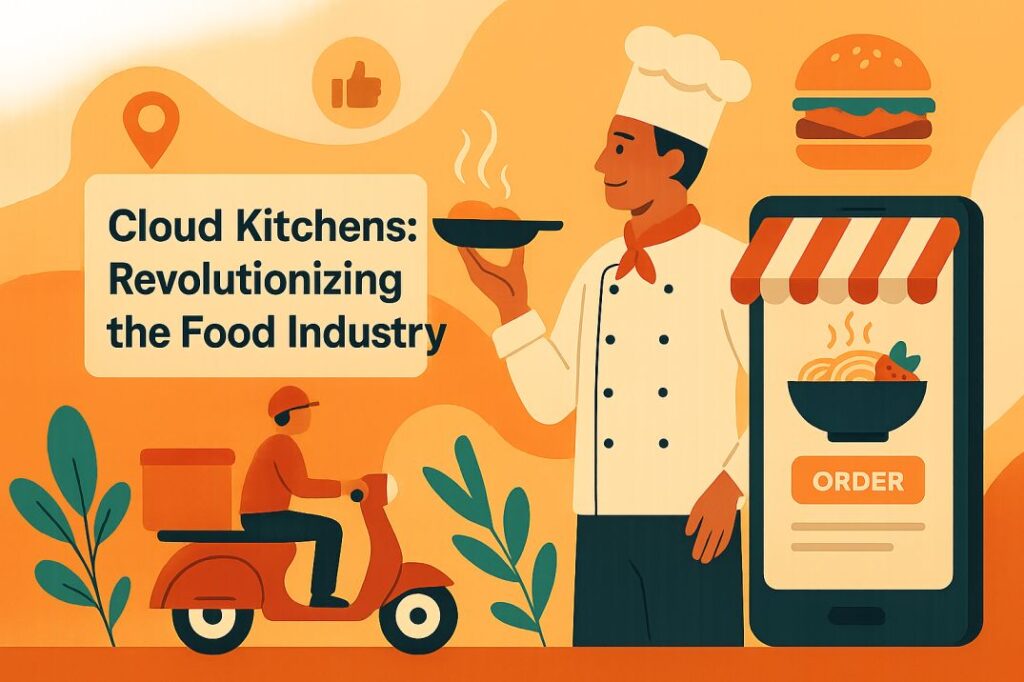Imagine this: You’re craving your favorite biryani at 11:30 PM. You open your food delivery app, scroll a bit, and boom—hot, spicy biryani is at your doorstep in 30 minutes. No crowded restaurants, no parking hassle, no waiting for a table. Magic? Nope. It’s called a cloud kitchen, and it’s flipping the traditional food business on its head.
Welcome to the behind-the-scenes kitchen revolution that’s transforming how we cook, deliver, and devour our favorite foods.
What Exactly Is a Cloud Kitchen?
Think of cloud kitchens as restaurants without the front-end—no dine-in, no décor, no waitstaff. Just a professional kitchen, a team of cooks, and a lot of incoming delivery orders.
Sometimes known as ghost kitchens, virtual kitchens, or dark kitchens, these setups exist solely to fulfill online food delivery. They operate from remote locations (sometimes even basements or warehouses) and deliver through platforms like Zomato, Swiggy, Uber Eats, and even their own apps.
It’s like the Uber of food, but with fewer honks and more hunger.
Why Are Cloud Kitchens Booming Right Now?
Let’s break it down with some real-world reasons:
🛵 1. Skyrocketing Food Delivery Demand
From college students to working couples, people are ordering in more than ever before. Late-night cravings, busy schedules, or just sheer laziness—whatever the reason, the demand is high and growing.
Cloud kitchens are built for speed, convenience, and scale, which makes them perfect for this new lifestyle.
💰 2. Lower Setup and Operating Costs
Opening a traditional restaurant in a high-footfall area is expensive. Rent, furniture, fancy lighting, and staffing—it adds up quickly.
A cloud kitchen, on the other hand? You just need a functional kitchen, a small team, and an internet connection.
It’s like running a restaurant on Wi-Fi.
🧠 3. Data is the New Masala
Since cloud kitchens rely heavily on technology, they collect real-time data: what people are ordering, when, and how often.
That means the kitchen can tweak the menu, pricing, and promos to match exact customer behavior. Traditional restaurants? Not so much.
Different Types of Cloud Kitchens
Not all cloud kitchens are created equal. Here’s a simple breakdown:
🍱 1. Single Brand, Single Kitchen
One brand, one kitchen, one menu. Think of your favorite online-only momo place—that’s probably it.
🧁 2. Multi-Brand Kitchens
A single kitchen serving multiple virtual brands. You might order a pizza and a smoothie from what seems like two different restaurants—but they’re made under the same roof.
It’s like a culinary multiplex.
🔄 3. Aggregator-Owned Cloud Kitchens
Biggies like Zomato and Swiggy run their own kitchen spaces and rent them out to food entrepreneurs. It’s like co-working spaces, but for chefs.
🧪 4. Hybrid Kitchens
These are restaurants that serve dine-in customers but also run a cloud kitchen on the side for extra income. Smart, right?
Benefits of Cloud Kitchens for Entrepreneurs
Starting a food business used to be a risky affair. Now? It’s a lot more accessible.
✅ Lower Risk, Higher Returns
Lower investment means you don’t need to bet your life savings to start.
✅ Experiment-Friendly
Want to test a new concept like sushi dosas or chocolate samosas? Cloud kitchens let you test, learn, and adapt quickly.
✅ Scalability is a Breeze
If your brand picks up, you can open multiple cloud kitchens in multiple cities, all without spending crores.
✅ Location Doesn’t Matter (Much)
You don’t need a prime location. A good delivery radius is enough. Even an industrial area can turn into a food hotspot.
But Hey, It’s Not All Butter Chicken and Rainbows
Let’s be real—cloud kitchens come with their own set of spicy challenges.
❌ Fierce Competition
Since the entry barrier is low, everyone’s jumping in. Standing out requires killer branding and consistent quality.
❌ Dependency on Delivery Platforms
A huge chunk of business comes through apps like Swiggy or Zomato, which means commissions can eat into your profits.
❌ Customer Loyalty is Fragile
Online users are just one bad review away from switching to your competitor. Brand loyalty is harder to build without physical touchpoints.
❌ Food Quality and Packaging
Food must survive traffic, bumpy rides, and time—all while staying hot and tasty. That’s a tall order.
Who’s Winning the Cloud Kitchen Game?
From large chains to home chefs, everyone’s playing.
- Rebel Foods (Faasos, Behrouz Biryani): Runs multiple brands under one roof across hundreds of locations.
- Box8, FreshMenu, and EatFit: Cloud-native food brands built exclusively for delivery.
- Local Heroes: Home chefs and small restaurants are using cloud kitchens to go online without burning a hole in their wallet.
How to Start Your Own Cloud Kitchen (In a Nutshell)
If you’ve got the hunger to build a food brand, here’s a quick roadmap:
- Pick a niche: Biryani? Vegan bowls? Desserts? Choose wisely.
- Design your menu: Keep it short, unique, and delivery-friendly.
- Get licensed: FSSAI, GST, fire safety—you know the drill.
- Choose your location: Focus on delivery zones, not footfall.
- Partner with aggregators: Or build your own delivery fleet.
- Market like a boss: Use social media, influencer collabs, and SEO (like this blog 😄).
The Future of Cloud Kitchens
Here’s where it gets exciting.
- AI-Powered Menus: Your kitchen may soon offer customized meals based on your past orders.
- Robotic Cooking: Automation is coming faster than we think.
- Hyperlocal Brands: Niche, neighborhood-level brands that feel personal and curated.
With rising urbanization, tech penetration, and evolving eating habits, cloud kitchens are not a trend—they’re the new normal.
Final Bite
In the world of food, change is the only constant—and cloud kitchens are proof. They’re leaner, smarter, and better adapted to the way we live and eat today.
So the next time your butter paneer shows up at your door piping hot, remember: It may have come from a kitchen you’ll never see—but it’s part of a revolution you’re already a part of.
Bon appétit, and welcome to the cloud!

